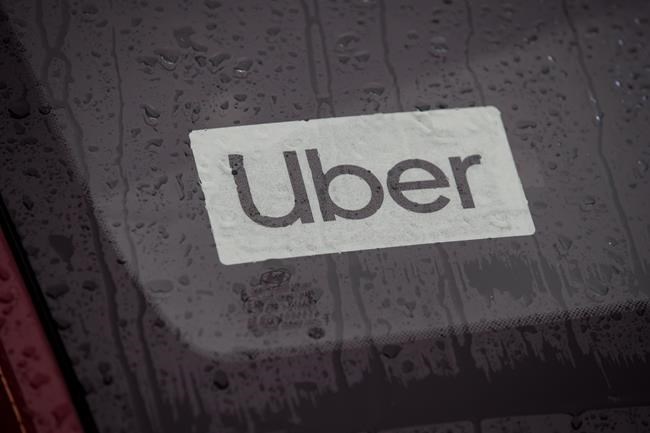TORONTO ŌĆö Uber Technologies Inc. revealed more details Monday of a labour model itŌĆÖs pitching Canadian provinces and territories, a model that has drawn opposition from some worker groups.
The Flexible Work+ model the San Francisco-based tech giant has pushed since March asks provinces and territories to force Uber and other app-based companies to create a self-directed benefit fund to disperse to workers for prescriptions, dental and vision care, RRSPs or tuition.
Labour groups have criticized the model for falling short of designating gig workers as employees and not providing more job security and consistent benefits, but the company is sticking with the pitch and on Monday, offered a glimpse of how it thinks the fund should operate.
Uber wants the fund to be managed by the industry but enabled by provinces and territories. App-based companies, it suggests, would provide dataon hours and earnings accrued by workers, who would qualify for varying benefits levels based on their numbers of ŌĆ£engaged hoursŌĆØ per quarter.
Uber considers engaged hours to be time spent accepting a trip or delivery or travelling to pick up or drop off a passenger or food. Uber thinks time logged into platforms or awaiting orders should not count because gig workers often keep several apps running at once or open them just to check traffic or demand.
Once a workerŌĆÖs aggregate hours surpasses a quarterly threshold, Uber suggests their gross earnings and tips should be multiplied by benefit rates set for their amount of completed work and then deposited into an account.
For those working 15 hours a week, there would be a two per cent rate giving them about $800 in benefits a year and for people who work 35 hours a week, there would be a four per cent rate resulting in $2,500 of annual benefits.
Each app-based company would provide a share of the benefits commensurate to the amount of work a person performed for them, but workers would be able to allocate the money to any type of benefit that suits them.┬Ā
For example, some could use the money to fund schooling, while others might put it towards an RRSP or vision care.
Brice Sopher, an Uber courier in Toronto and vice-president of Gig Workers United, said the proposal fails to address ongoing issues workers face such as a lack of help with equipment costs and low rates of pay.
"Some weeks, I get a lot of orders, and I make a lot of money," he said. "Some weeks, I don't get a lot of orders, and I am out there working at 12 a.m. on a Sunday to try to get the amount I need."
He is disappointed by Uber's definition of engaged time, which is often out of a courier or driver's control and will omit periods when workers are awaiting jobs but eager to work.
He also has concerns about the fund being industry-run because that could leave workers with few ways to seek justice and little outside oversight, if they disagree with payment calculations or if a company goes bankrupt.
Simply put, Sopher said the plan "doesn't have gig workers in mind."
"We are pawns being used for them to get what they really want, which is the relegation of us to a second tier status as workers, where we will be denied the right to unionize, where we will not have any recourse."
The Canadian Labour Congress had a similar message.
ŌĆ£Nobody goes to work asking for more insecurity and vulnerability, but thatŌĆÖs what Uber is offering their workers," President Bea Bruske said in an email.
ŌĆ£Uber has dictated the terms of their workersŌĆÖ employment, offloading costs like gas and car repairs onto its employees and isnŌĆÖt even held accountable for providing basic employment standards, like a minimum wage and vacation pay."
Like many Uber critics, her organization believes the company has ŌĆ£misclassifiedŌĆØ workers using its platform as independent contractors ŌĆō people who arenŌĆÖt employees because they can choose when and how often they work, and who donŌĆÖt receive sick leave, vacation time or health care benefits.
Uber has long argued workers value that flexibility, which would be lost if they were made employees, and says many people only work for the platform a few hours a week or part-time and already access benefits through spouses, parents or other jobs.
The company commissioned an October survey of more than 600 Uber couriers and drivers in Canada, which showed 65 per cent favoured Flexible Work+. Roughly 16 per cent still like the current independent contractor model and 18 per cent wanted to be classified as employees with benefits.
But court cases paint a different picture.
The U.KŌĆÖs Supreme Court ruled in February that Uber drivers are employees and are entitled to minimum wage and holiday pay.
Earlier this month, Ontario's Superior Court of Justice certified a class-action lawsuit against Uber, which advances a fight to get some of the platform's Canadian couriers and drivers recognized as employees.┬Ā
Days later, Alameda County Superior Court Judge Frank Roesch struck down Proposition 22 ŌĆö a California ballot measure exempting gig-based platforms from classifying workers as employees eligible for benefits and job protections.
This report by The Canadian Press was first published Aug. 30, 2021.
Tara Deschamps, The Canadian Press

